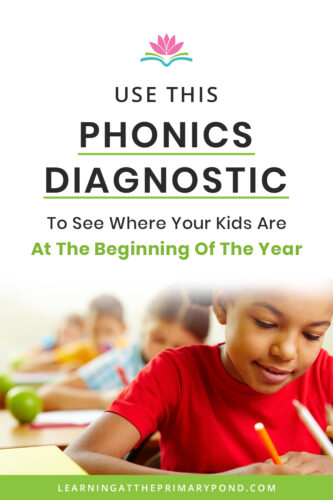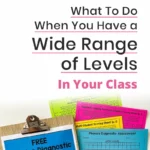More than ever, our students are coming to us with a BIG range of ability levels.
Some students are, unfortunately, really far behind. However, some have been thriving and are actually ahead!
But how do you know where to go at the beginning of the school year? How do you meet this big range of needs?
Having an assessment that’s easy to use AND provides data that’s easy to understand is key. You’ll also want the information to be transferred into clear, actionable steps.
In this post, I’ll go through a free diagnostics assessment I offer. I’ll explain how to use it, the different components, and most importantly, what to do with the information once you’re done.

What Is A Phonics Diagnostic?
A phonics diagnostic, or assessment, is used to “diagnose” or identify the strengths and areas of growth for students in your classroom. The assessment should help you determine exactly what phonics patterns students can decode (read) and encode (spell). Then, based on each student’s results, you can identify skills students already know as well as gaps in their phonics knowledge.
And this is incredibly valuable, because the results will give you the exact next steps to help kids move ahead in their reading and spelling!
In this assessment, there are 3 parts:
- Letter-Sounds Diagnostic – In this portion, students are asked to produce the sounds that each of the 26 letters makes.
- Diagnostic Spelling Test – Students will be asked to spell words focused on each of the skills listed below.
- Diagnostic Word Reading Assessment – Students will be asked to read words focused on each of the skills below.
Here are the skills included in the reading/spelling assessment:
- VC words
- CVC words
- Digraphs
- Consonant blends
- Double final consonants
- Glued sounds
- Silent e words
- R-controlled vowels
- Inflectional endings
- Vowel teams
- Closed syllable exceptions
- Y as a vowel
- Diphthongs
Having students both read and spell words with the patterns listed above will provide you with tons of helpful information. Quite often, students are at different places on the continuum for reading vs. spelling. (Usually they can read words before they can spell them.)
In the assessment, I also offer guidance on when to skip parts for efficiency. For instance, in the letter-sound portion, if a student doesn’t know the first 8 letters, my recommendation would be to stop because you’ve already received enough helpful data on gaps.
Some of the components can be given in a large or small group setting (like the spelling test), whereas others should be administered in a one-on-one setting so that you can get accurate data for individuals.
Here’s an example of what one of the word reading pages looks like:

Students start at the top and read through each word, left to right (you can cover up some words with white paper and reveal them when students get to that point, so as to avoid overwhelming students with tons of words at once). Once a student has read 5 words incorrectly, stop this portion of the assessment.
As you can probably see, different words on the assessment address different phonics skills. For example, “Ed” is a vowel-consonant word and “curb” has an r-controlled vowel.
This resource has options for teachers to mark students’ answers on either a single assessment scoring sheet or a multi-student assessment scoring sheet. See examples of each here:


Some teachers prefer one or the other and some even like to start with the single and then transfer to the multiple, so I wanted to offer both options!
You’ve Completed The Diagnostic – Now What?
After completing the phonics assessment for your student(s), you’ll have lots of information at your fingertips! You’ll see things that students were able to do, but also most likely skills that students aren’t familiar with.
We can look at this data through a waterfall analogy. We can start big picture, trickle down to group trends, and then end with individual takeaways. Here’s a list of questions you should ask yourself (and write down answers to) when reflecting on the data:
- What are some strengths our class has as a whole? (at least 2/3 of the class was able to do)
- What are some areas of growths our class has as a whole (at least 2/3 of the class wasn’t able to do)
- Are there certain skills that a group of students is really advanced in? (i.e. 5 Kindergarten students were able to spell words with digraphs)
- Are there certain skills that a group of students had trouble with? (i.e. 6 1st grade students weren’t able to decode CVC words)
- Are there individual students who are advanced in particular skills? (i.e. one 2nd grade student could read and spell words with diphthongs)
- Are there individual students who are fairly behind in certain areas? (i.e. one 1st grade student who can only identify 10/26 letter sounds)
Answers to these questions will help you determine how much phonics instruction you should do in whole group, small group, and 1:1.
If a majority of your class is at (more or less) the same starting point, you’ll be able to do a lot of your phonics instruction whole group. This will help maximize the instructional time your students are getting to cover the same skills.
However, if your class has a pretty wide variety of skill levels, you’ll most likely want to be doing most of (but not necessarily all of) your phonics instruction in a small group setting. This will allow you to tailor each small group lesson around a different skill that matches the ability level of the group.
If you’re seeing some individual outliers (high and low), you’ll want to make notes of how you can incorporate this one-on-one instruction throughout the day/week. Maybe you can provide differentiated materials to this student during phonics time. If you have an aide, they can pull the student to work on the specific skills.
Materials To Use For Intervention
Trying to find or create materials for a vast array of abilities can be difficult and time-consuming!
That’s why I developed my Reading Intervention products:

The skills covered in these resources mimic the skills addressed in the phonics diagnostic. The intervention packs are no-prep (just print and they’re ready to go!), flexible (you can decide how many activities to do per day), structured/consistent, and data-driven (assessments are provided throughout each resource.)
Here are the different intervention packs available:
- Letter sounds
- Short vowels/CVC words
- Beginning and ending digraphs
- Double final consonants
- Beginning/ending consonant blends & glued sounds
- Long vowels with silent e
- Inflectional endings
- R-controlled vowels
- Vowel teams
- Diphthongs
In each intervention pack, students will have tons of opportunities to practice encoding and decoding. The packs vary somewhat depending upon the skill, but generally they include:
- Identifying pictures that have the target sound
- Tracing (with a finger and writing utensil) the letters for multisensory practice
- Blending to read words with the target phonics pattern
- Using magnetic letters or paper letter tiles to build words with the target phonics pattern
- Reading real and nonsense words with the target phonics pattern
- Reading sentences containing words with the target phonics pattern and simple high frequency words
- Reading and answering questions about a decodable passage for the phonics pattern
There’s a teacher manual included with every resource, so you will have tons of support on how to teach and guide students with the particular skill.
Conclusion
Having an assessment at the beginning of the year will provide you with the necessary tools to start the year strong. You’ll have a much better idea as to where everyone is starting (as well as a goal for where you’re going)! I also highly recommend giving this assessment at other times throughout the year to see how students are progressing.
If you’re interested in checking out my FREE phonics diagnostic assessment, click here to get access!

If you want to learn more about how to pace your phonics instruction once you’ve begun the year, check out this blog I wrote called: How Do I Know If My Phonics’ Pacing Matches My Students’ Needs?
Happy teaching!














Thank you. This is perfect for when I believe a child has finished instruction, It will show me if there are still some holes. Thank you!
Glad to hear! Good luck!